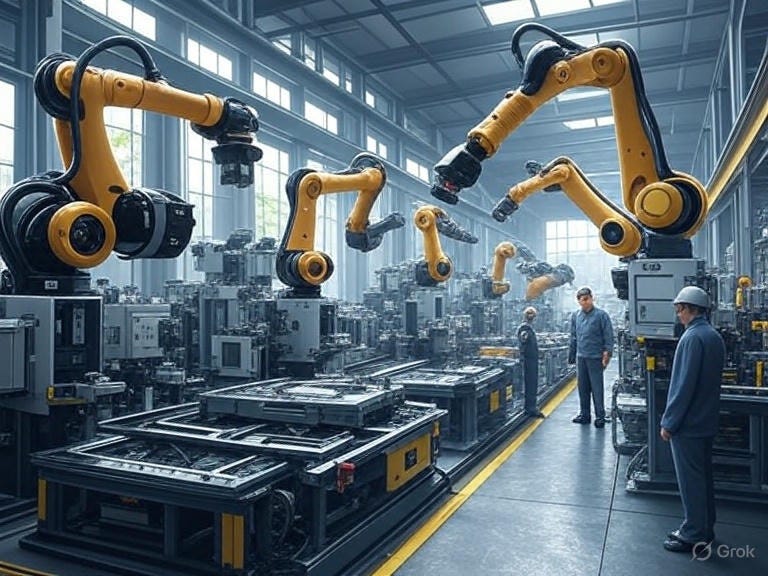Context: as China’s economy heads into the second quarter, and as its government prepares the 15th Five Year Plan, there’s plenty of discussion and debate as to what the challenges and opportunities are, and what policy priorities and targets the Plan should include. This essay is an intervention into a debate on the centrality or otherwise of consumption as a key policy variable, and how it is that the issue of ‘involution’ can be understood and addressed.
As China’s governing party prepares the 15th Five Year Plan, there’s a lot of recent attention being placed on the question of “involution competition”, what it means and portends, and what is to be done about it. Profit compression across various sectors is often associated with the presence of “involution”. Claims are that weak domestic consumption demand coupled with excessive capacity is driving intensive competition with flatlining profit growth and deflation supposedly evidencing an economy on the edge of crisis. The response, from various mainstream quarters, is to boost household consumption in absolute terms and as a proportion of GDP. The argument, in short, is that households are under-consuming, saving too much; and that high savings rates are financing excessive levels of investment. Put the other way, the proposed response would see investment and savings rates fall as consumption levels rise.
There is a superficial appeal to this line of reasoning. But it is misplaced. It mischaracterises the dynamics of China’s economic growth, and inverts the cause-effect relationship between consumption and investment, assuming that savings is a constraint. The relationship between credit dynamics and system profitability is also not examined, when it is overall liquidity that underpins aggregate profits across the economy at large. Variations in profitability across sectors has as much to do with structure features associated with technological distribution as it does with anything else.
Mainstream claims and arguments
Let’s begin with the mainstream claims and arguments.
Household consumption demand has exhibited consistent and stable growth over the past decade or more. It hovers around 5% year on year growth in real terms, and is underpinned by steady real wages growth over the same period. The overwhelming majority of China’s economic output is consumed by domestic enterprises and households. In manufacturing, where China experiences a trade surplus (that is, exports more than it imports) the ratio of exports to output has steadily declined over the past 20 years from a peak of about 36% in 2007/08 to present levels of around 20%. In other words, about 80% of manufactured outputs are consumed domestically. This is noteworthy given that manufactured outputs have grown from $625 billion in 2003 to over $4.5 trillion in 2023, which indicates that domestic consumption of Chinese manufactured outputs has grown faster than outputs.
None of this suggests that tepid (or “weak”) consumption is a drag on the economy at large. If consumption levels continue to rise, the argument that is frequently advanced is that it remains too low as a proportion of GDP. Because GDP is an accounting balance, changes to consumption necessarily mean changes in the other factors - namely, Government, Investment (and savings) and net exports. This narrow ‘balance sheet’ framework often leads to causal claims that investment crowds out consumption; and that excessive savings leads to wasteful investment. Household incomes are being suppressed in favour of capital accumulation.
Let’s unpack this set of claims.
These days, final consumption contributes almost 56% of GDP (2023), rising from 49.35% in 2010, according to data from Statista. This growth is often ignored in many mainstream commentaries, but is prima facie evidence of an ongoing evolution in the structure of China’s economic metrics. It is also worth noting that the nadir of 2010 came after a near three decade period of decline, from a high of 67.3% in 1983. Casting our eyes further back, we can note that private consumption’s contribution to GDP reached a peak of 70.8% in 1962.
That said, prevailing measures of household consumption tend to understate real consumption. This is so in three respects. Firstly, there are real price effects. Chinese households are beneficiaries of low cost products and services, and are able to satisfy their requirements by spending a relatively smaller proportion of their regular income. The residual is savings, which is therefore not a constraint on investment. In real, material terms (actual number of things rather than the monetary value as the measure), Chinese households (and enterprises) get substantial ‘bang for their buck’. Secondly, official statistics tend to undercount consumption in any case. Thirdly, there are many services that are consumed ‘free of charge’ because they are either heavily subsidised or provided free of charge by public authorities. Such free public goods are an important part of social welfare. Oliver Kim has recently mused that perhaps “China is in fact overconsuming, relative to an income level that is much lower than is officially reported.”
The argument is then extended to argue that because consumption levels are too low (often words like “weak” are used), excessive capacity invariably engages in ruthless price cutting to attract sales. Here, questions of consumption are used to explain the presence of “involution”, which is evidenced, so the claims go, by compressed profits and deflation (i.e., absence of inflation). The ‘answer’ to this is to cut investment and drive up household consumption, with the implication further being that household savings must be reduced as well. Otherwise, Chinese industry will have no choice but to expand exports and cause global trade imbalances. That Chinese trade exposed sectors - such as manufacturing - are predominantly servicing the domestic market, as noted above, seems to have been missed by those who continue to claim that China’s industrial expansion is premised on exports growth. It’s not.
Be that as it may, what is clear is that China today is a wealthier society than it was in 1983 or, indeed 1962, when consumption as a percentage of GDP was far higher than it is today. This immediately suggests that we cannot easily infer welfare from GDP compositional indicators as if there is some pre-ordained benchmark that speaks of prosperity. Focusing on consumption as a proportion of GDP obscures the simple fact that GDP itself is not static. In rapidly growing economies, GDP can expand far faster than household consumption, mechanically reducing the consumption share even as absolute consumption rises dramatically. By this metric, earlier periods in a country’s development may appear “more normal,” despite much lower standards of living. The percentage alone tells us nothing about real welfare or per capita consumption.
Put plainly, the proportionate contribution of consumption to GDP in and of itself is not a very useful benchmark to understanding social and economic welfare. It also implies that consumption and investment are trade-off alternatives, when in fact (as I will argue below), they are actually symbiotically interwoven with each other in circuits of capital accumulation, production and consumption. Far from being alternatives, in a dynamic system - as opposed to a static GDP balance sheet framework - it is investment that is the principal determinant of growth.
Alternative Analysis
An alternative analysis is needed to make sense of China’s development model, its evolving economic structure and its trajectory. Rather than anchor our understanding of China’s economy through the lens of static GDP compositions, I argue that long-term growth depends on autonomous demand, that is components of demand that do not depend on current output, such as government expenditure, exports or autonomous investment. In China’s case, investment has been the dominant autonomous driver, powering decades of extraordinary growth. Real wages and consumption have risen in tandem with this process, as income growth induces higher household spending.
From this perspective, consumption is not the prime mover of the growth cycle. Rather, it follows income growth, which in turn follows investment expansion. Attempts to reverse this causality - by substituting higher consumption for weaker investment - misread the structural sequence. Without continued investment, capacity growth stalls, productivity improvements decelerate, and income growth weakens. In other words, investment plays a dual role that is largely ignored in mainstream assessments. Investment is not an alternative to consumption; it is a driver of future income and, by extension, future consumption. An economy with high investment today may see higher household income and consumption tomorrow. Viewing consumption shares in isolation, without considering the multiplier effect of investment, presents an incomplete and misleading picture.
China’s investment-led growth model has historically relied on credit expansion as the lubricant of accumulation (for a lengthier exposition of this model, see my earlier essay). When credit grows rapidly, liquidity injections fuel investment, support asset valuations, and enhance realised profits across sectors. This is because, in a monetary production economy, profits are realised through monetary circulation, not just physical surplus. This dynamic is best captured by focusing on the rate of change in credit growth rather than its absolute level. When credit growth accelerates, firms experience two reinforcing effects. First, faster credit growth finances higher investment, which in turn raises output and sales. We saw this in two main recent spurts: property or real estate expansion in the 2010s, and more recently the rapid expansion of high tech manufacturing. Second, higher system liquidity improves working capital cycles and asset valuations, amplifying profit expectations. This delivers a liquidity premium on profits. Conversely, when the rate of credit growth slows - even if credit stock remains high - profit realisation tightens disproportionately. The momentum loss matters as much as the level.
Following the 2008 global financial crisis, China’s policymakers unleashed an unprecedented credit expansion to stabilise growth. Total Social Financing surged, investment boomed, and corporate profitability improved dramatically in many sectors. However, from 2017 onward, financial regulators pivoted toward deleveraging to contain systemic risk. Credit growth decelerated sharply, especially in shadow banking channels and property-related lending. While this improved financial stability metrics, it also introduced liquidity drag into the real economy. Combined with structural overcapacity, this produced a powerful profit squeeze, magnified in sectors where prior profits were heavily leverage-dependent (e.g., real estate, construction supply chains).
The critical point is that profits are claims on circulating liquidity. When liquidity creation slows, these claims cannot all be validated at prior levels, especially in a context of stagnant or falling utilisation. Unlike in barter models, where surplus output guarantees profit, in a credit-money economy the profit share depends on the pace of monetary expansion relative to distributional commitments and productive capacity. Note that low profit rates are not, as such, a function of price competition per se; this is a symptom of a slow down in system liquidity expansion.
Let’s take a look at recent data to illustrate these points.
China’s National Bureau of Statistics (NBS) recently reported that the profits of major industrial firms declined by 1.7% year-on-year during the first seven months of 2025, amounting to 4.02 trillion yuan. In July alone, profits slipped 1.5% from a year earlier, but the pace of decline narrowed compared to June. Significantly, manufacturing sector profits rose 6.8% in July, accelerating from 1.4% in June. This is more than a short-term fluctuation; it reflects distributional shifts, technological substitution, and structural reallocation of surplus value.
We need to examine the relationship between wages and profits, at a given technology and relative prices. The economy’s rate of profit is not set by marginal productivity but emerges from the interplay between the real wage, the technical coefficients of production and the composition of inputs (labour, capital goods, and intermediate commodities). The reported 1.7% fall in aggregate industrial profits suggests an overall profit squeeze. This typically happens when unit labour costs rise faster than productivity, intermediate input costs increase (energy, raw materials) and output prices remain rigid in competitive sectors. Given China’s industrial policy emphasis on raising household incomes and maintaining price stability, these dynamics reflect a structural trade-off: supporting wage growth to boost domestic demand while preserving profitability for capital accumulation. The trade-off in system terms is not between investment and consumption; it’s between wages growth versus profit growth.
The headline figures conceal a critical sectoral trend: manufacturing profits surged 6.8% in July, compared to a modest 1.4% rise in June. This divergence points to sectoral redistribution of surplus. Labour-intensive and low-tech industries - such as textiles, basic processing, and some resource-based sectors - continue to face pressure from rising wages, weak external demand, and input cost fluctuations. High-tech, capital-intensive manufacturing - particularly in electronics, new energy vehicles, and advanced equipment including robotics - benefits from productivity gains, policy support, and favourable relative prices (e.g., cheaper energy and commodity inputs). This situation results from differences in capital–labour ratios and intermediate input dependence across industries. Capital-intensive sectors can spread fixed costs over larger output, enjoy technological rents, and substitute labour with automation, thereby stabilising or even raising profit margins despite rising wages.
The July data, therefore, signals more than cyclical variation. Rather, it highlights a long-term structural dynamic, namely the ongoing substitution of technology for labour. As profit margins in labour-intensive sectors compress, firms respond by investing in automation, robotics, and AI-driven processes to reduce reliance on human labour. This alters the technical coefficients of production: direct labour requirements per unit of output decline, and the input of fixed capital goods rises. Such changes in technique affect the standard commodity, shifting the economy’s underlying structure toward capital-intensive production. This substitution is not merely cost-saving; it drives productivity growth, which can offset the distributional effect of higher real wages. As labour requirements fall, the maximum rate of profit rises, even if real wages remain constant. The result is a partial resolution of the wage–profit conflict through productivity gains.
Technology substitution within China coincides with a geographic reallocation of labour-intensive production. Domestically, activities such as garment production or basic assembly are increasingly relocating to central and western provinces, where wages remain lower than in the coastal manufacturing hubs. Internationally, global value chains are fragmenting further, with labour-intensive segments moving to Vietnam, Bangladesh, and emerging African manufacturing centres. This dynamic mirrors the Lewis dual-economy model, but with a global twist: instead of drawing surplus labour into the capitalist sector, Chinese capital is now externalising labour intensity to maintain competitiveness and profit margins in price-sensitive markets.
This implies a reduced labour share in China’s economic output as an abstract whole (what Sraffa would have called the ‘standard commodity’). It also means increased import dependence for certain intermediate goods (produced in offshore low-cost regions) combined with a continuing rise in the organic composition of capital in China’s domestic economy.
China’s profit dynamics cannot be separated from its broader structural transformation strategy. Since 2017, policymakers have deliberately shifted credit allocation and industrial policy support from real estate and construction - labour-intensive, low-productivity sectors - toward strategic emerging industries such as semiconductors, EVs, and AI-enabled manufacturing. This rotation changes the sectoral composition of the surplus, with more profits concentrated in technologically advanced industries. This further impacts the determinants of the general rate of profit, as capital-intensive sectors with long production periods become dominant. As a result, the distributional balance between wages and profits changes, as these sectors rely on high-skilled labour while automating low-skilled functions. The July data reflects these structural shifts: overall industrial profits are under mild pressure, but profits in high-tech manufacturing are rising strongly, consistent with the policy goal of building “new productive forces” (新质生产力).
Another point to note is the importance of relative price movements. Changes in input costs can redistribute surplus among sectors without any change in the money wage. For example, if energy and commodity prices fall, raw material producers lose, but downstream manufacturers gain. If imported intermediate goods become cheaper (due to exchange-rate appreciation or global price normalisation), high-tech manufacturers benefit disproportionately. Recent improvements in global supply chains and a stable or moderately appreciating renminbi likely contributed to cost stabilisation in manufacturing, supporting its profit rebound in July.
The general rate of profit acts as the gravitational centre for investment and accumulation. A 1.7% decline in aggregate profits suggests pressure on accumulation, unless concentrated profits in dynamic sectors offset aggregate weakness. This appears to be happening: capital-intensive, high-tech industries are securing rising profits, sustaining investment momentum in strategic sectors. However, the structural path has two critical implications:
Rising organic composition of capital: Profitability in dominant sectors depends increasingly on productivity growth and cost control, making the system sensitive to technological innovation; and
Potential domestic demand challenges: If labour demand grows more slowly than output, the wage share in national income may stagnate, limiting consumption growth unless offset by public redistribution and foundational economy expansion.
Technology substitution alters the wage–profit trade-off. As labour coefficients decline, the maximum rate of profit increases, giving the system more flexibility to accommodate higher real wages without eroding profits. However, this also reduces labour’s bargaining power, especially for low-skilled workers displaced by automation. Unsurprisingly, the State steps in to compel increases in the minimum wage. The risk is employment polarisation grows, with rising wages and opportunities for skilled workers, but job losses for low-skilled labour unless new sectors (e.g., services, care economy) absorb them.
Challenges and Priorities
China’s challenge is to maintain a high-wage, high-productivity system, not a low-wage race to the bottom. This requires the following:
Continuous technological upgrading;
Redistributive mechanisms to sustain domestic demand; and
Expansion of the foundational economy (public services, infrastructure) to provide employment and welfare security.
The NBS profits data does not signal simple cyclical weakness or even one of capacity overhang per se; it reveals a system undergoing profound transformation. The modest contraction in aggregate industrial profits, alongside a surge in manufacturing profitability, reflects a reallocation of surplus value from old, labour-intensive sectors to advanced, capital-intensive ones. This refracts a shift in the capital–labour mix through technology substitution and automation, and is also evident by way of a geographic relocation of labour-intensive production to lower-cost regions, both within China and globally.
These trends alter the economy’s technical conditions of production, raise its maximum rate of profit, and reshape the distributional landscape. Yet they also pose new challenges: managing domestic demand, ensuring social stability, and maintaining a dynamic rate of accumulation in an economy where labour is no longer the central engine of growth.
Periods of stagnant or declining profits - often described as involution - reflect structural constraints in the production system, particularly the balance between wages, profits and the underlying technical coefficients. In China’s case, the modest contraction of aggregate industrial profits alongside rising profitability in high-tech manufacturing signals a reallocation of surplus toward capital-intensive, technologically advanced sectors. Resolving involution requires strategies that simultaneously enhance profitability, productivity, wages, and system liquidity, while also anticipating the long-term impact of demographic shifts.
Technology investment plays a central role. By substituting capital for labour in routine or low-productivity tasks, firms reduce unit labour costs, increase output per worker, and stabilise or raise the effective rate of profit. This changes the technical coefficients of production, expanding aggregate output and raising the ceiling for accumulation without squeezing wages. Automation, robotics, and AI-driven production not only restore margins in stressed sectors but also drive long-term productivity gains, supporting higher accumulation and maintaining competitiveness in international markets.
Productivity growth complements technological substitution. Process improvements, innovation, and better management increase output per unit of input, enlarging the surplus available for distribution. Higher productivity allows firms to accommodate rising wages while maintaining or improving profit margins, mitigating the traditional trade-off between labour remuneration and capital returns. In high-tech manufacturing, this has been evident in recent months, with profit growth accelerating despite pressures in other sectors.
Wage growth, when aligned with productivity gains, reinforces the cycle by expanding domestic demand. Rising wages do not necessarily depress profits if output per worker rises sufficiently. Higher wages also help maintain social stability, broaden consumption-led growth, and create a virtuous link between distribution and accumulation. This ensures that output finds a market, particularly for domestically produced goods, supporting both profits and sustainable growth.
Critically, these production and distribution strategies require adequate system liquidity and targeted commercial credit. Investment in technology and productivity-enhancing capital needs upfront financing. By ensuring sufficient credit availability, the system enables firms to implement automation, upgrade processes, and expand capacity without being constrained by short-term cash-flow pressures. Strategically directed credit can prioritise high-productivity sectors, reinforcing structural transformation while avoiding inefficient allocation to low-return areas. Liquidity provision also sustains working capital and wage payments, feeding back into domestic demand and ultimately supporting profit growth. It is a reinforcing loop between finance, production and distribution.
Looking to the long run, China’s demographic trajectory amplifies the need for these structural adjustments. A gradually ageing population implies slower labour force growth and rising dependency ratios. Labour scarcity in core sectors naturally exerts upward pressure on wages, which can be accommodated if productivity gains continue to expand output per worker. This demographic constraint accelerates technology substitution and automation, shifting the economy toward a higher capital–labour ratio and boosting overall productivity. Over time, labour-intensive production either relocates to lower-cost regions domestically or moves to global low-wage centres, while domestic sectors increasingly rely on automated, high-productivity processes.
These shifts have broader societal implications. As labour-intensive manufacturing becomes more automated, a larger share of the economy naturally moves toward the services sector, particularly areas that cannot be fully automated - healthcare, education, cultural industries, and leisure services. Rising wages, supported by productivity gains, fuel demand for these services, creating a structural expansion of consumption-led sectors. Automation and productivity improvements also open the possibility of more leisure time, reflecting both technological efficiency and social preferences, and reinforcing demand for service-oriented activities.
Public investment complements these private sector dynamics. Infrastructure, urban development, education, and healthcare become essential in supporting both productivity and social welfare, while absorbing labour displaced by automation. Investments in the foundational economy - public goods and essential services - not only enhance long-term productivity but also sustain domestic demand, helping stabilise profits and maintain social cohesion.
Taken together, the combined effects of technology investment, productivity growth, wage expansion, targeted credit, and public investment provide a coherent strategy to resolve involution while preparing the economy for a structurally transformed future. China’s industrial system is moving toward a high-productivity, high-wage, more automated economy, underpinned by strong public investment and a dynamically expanding services sector. Within this framework, profit growth, wage growth, and social development are mutually compatible, and the long-run trajectory points toward sustained accumulation, rising living standards, and a potential expansion of leisure and service-oriented economic activity.
I began this essay by discussing the mainstream tropes around notions of under-consumption, but clearly the argument is that this framing and focus is misguided. Consumption is induced, not autonomous. Higher consumption follows income growth, which depends on investment-driven productivity expansion. Attempting to drive growth through consumption alone is like trying to lift a cart without pulling the horse. Worse, it runs the risk of undermining overall system development (by way of productivity enhancing technological development), resulting in a lower-income economic trajectory with reduced surpluses available for social development.





